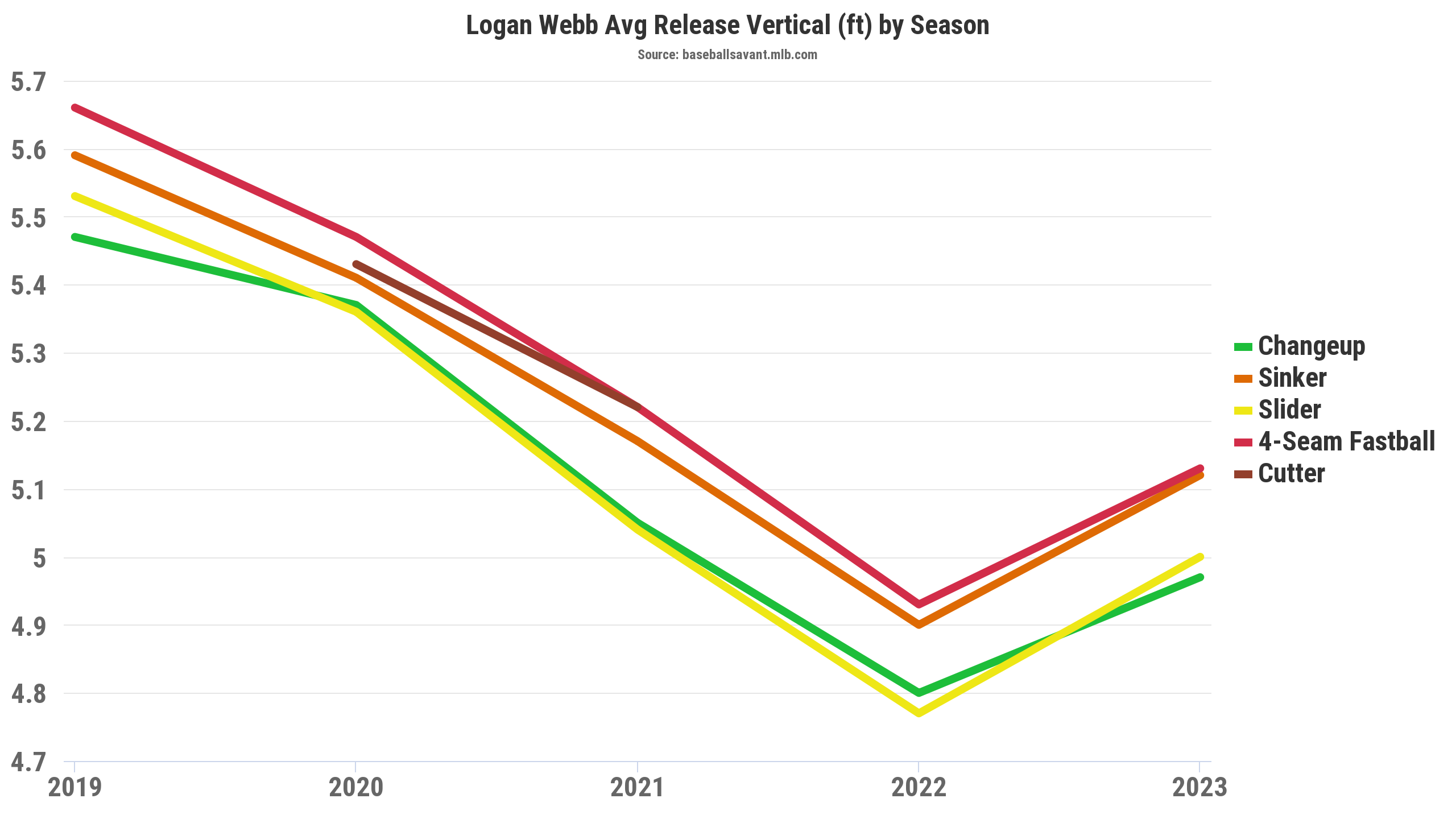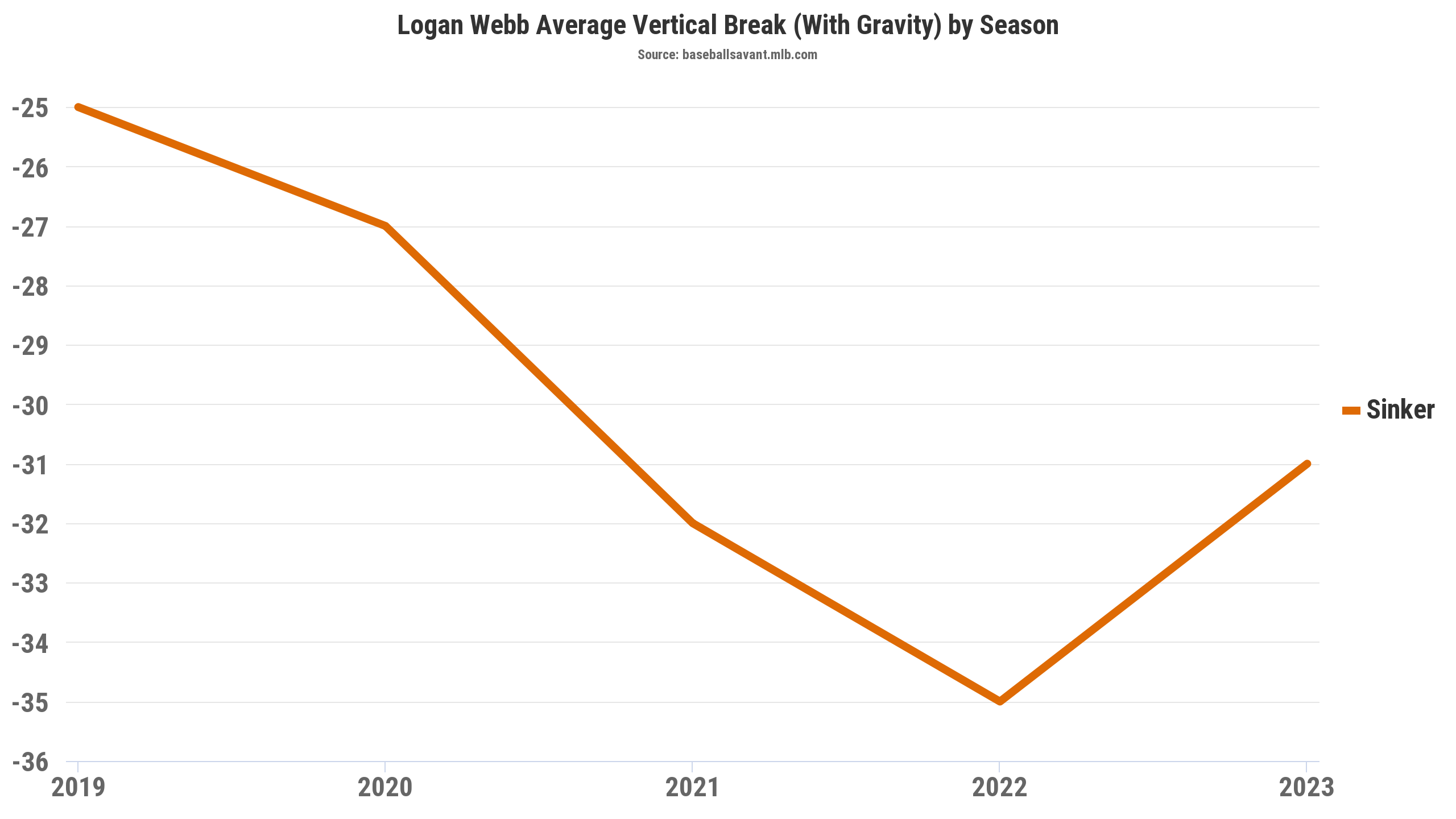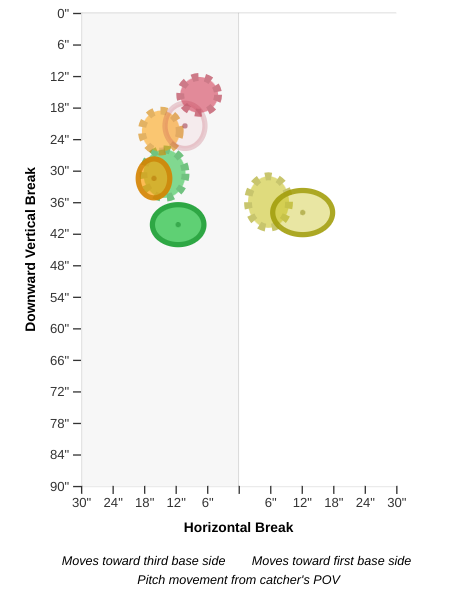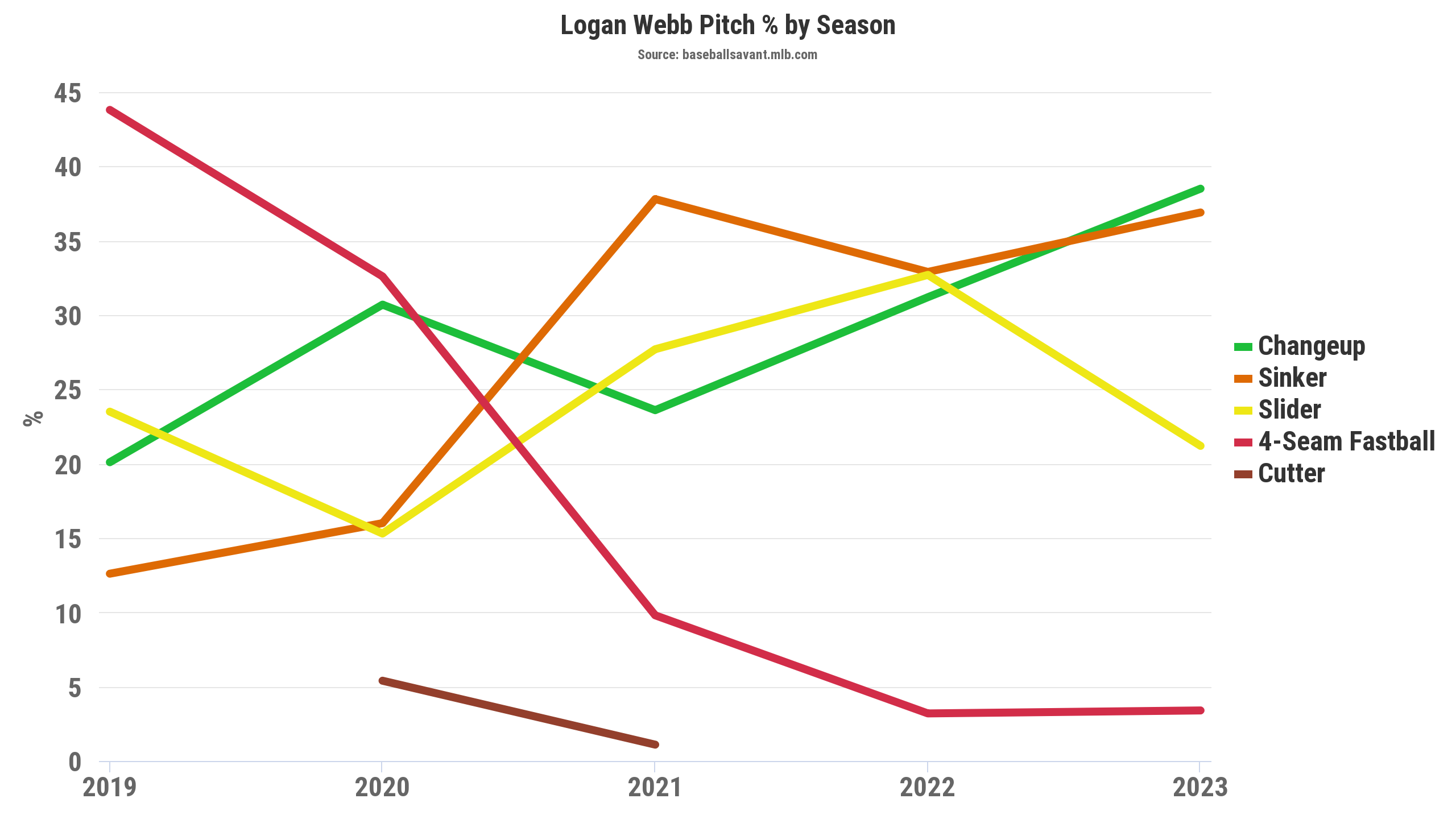When you think of Giants’ starter Logan Webb, you might think first of sinkers. Webb has used his low-90s sinker to great success over the past few seasons and established himself as one of baseball’s most consistent and effective starting pitchers. Webb has thrown just shy of 500 innings since the start of the 2021 season, posting a 3.11 ERA, a 3.04 FIP to match, and racking up more than 11 fWAR. Among 88 qualified starting pitchers over that stretch, Webb ranks 14th in games started, 8th in innings pitched, 17th in ERA, and 7th in fWAR. Thanks to that sinker, his 59.2% ground ball rate ranks 2nd-highest (behind only Framber Valdez). He’s truly one of the best starters in the game today.
While the sinker has been his calling card, his success belongs even more to his ability to evolve and adapt as a pitcher. Webb’s sinker-slider-changeup pitch mix is one of the most commonly deployed arsenals throughout baseball history, but he has taken advantage of modern pitch design and understanding to develop and use them in unusual ways. That fueled his rise to the top of his game and is now contributing significantly to his staying there over time.
Sinker Transformation
Webb wasn’t always a sinkerballer. He was the Giants’ fifth-best prospect (per MLBPipeline) and made his MLB debut in 2019 as a four-seamer, slider, and changeup guy that worked out of a pretty traditional three-quarters slot. Only 12.5% of his pitches in his rookie season were sinkers. Webb’s scouting profile on MLBPipeline did not mention his sinker, instead crediting his heavy, mid-90s fastball and power slider as potential plus pitches.
Webb started 8 games and worked 39.2 innings for the Giants that year while working to an unremarkable 5.22 ERA. He gave up five home runs in that small sample and had poor luck on balls in play (.333 BABIP) and stranding runners (65.4% LOB%). His FIP was a more respectable 4.12 and his xFIP, which normalizes home runs allowed to the league average rate, was even better at 3.89. Of note, though, was that his four-seamer was knocked around by big-league hitters to the tune of a .339 batting average, a .581 slugging percentage, a .407 wOBA allowed, and a -3.8 cumulative pitcher run value.
That offseason, Brian Bannister, who had just been hired as the Giants’ VP of Pitching Development, set about persuading Webb into a complete reinvention of how he worked. Travis Sawchik detailed the story for The Score late last season. Bannister scrapped the Giants’ old development plan for Webb (which consisted of high four-seamers and adding a cutter) and instead wanted to lower Webb’s arm slot to try to maximize the seam-shifted wake effects he was getting with his sinker. “They literally told me to throw sidearm,” Webb told Sawchik.

When the 2020 season started, Webb had a lower slot and continued to work with his four-seamer about a third of the time (down about 44% the season before), and it continued to get hammered (.430 wOBA).
By 2021, his slot was lower still and he operated as a full-fledged sinker-baller, throwing that pitch nearly 38% of the time while reducing his four-seamer usage to 9.8%. That sinker led the way and racked up 14.3 run value, the 7th-most of any sinker, and 27th-most of any pitch, in baseball that season.
As Webb’s arm slot dropped, so did his sinker. By 2022, the pitch had picked up about 10 inches of additional gravity-aided drop from his 2019 version, and the pitch had better than 30% more vertical movement than other sinkers at his low-90s velocity.

A Complementary, Seam-Shifted Arsenal
Webb’s sinker wasn’t the only offering in his arsenal that gained from his arm slot change. Research into seam-shifted wake has shown that two-seam-oriented pitch types tend to benefit more from these effects. Those pitch types include sliders (which is a big factor in the recent boom of horizontal breaking sweepers) and changeups.
Those just happen to be the other two pitches in Webb’s arsenal. PitcherList’s Aidan Resnick detailed Webb’s new and improved arsenal early in the 2022 season. Webb’s changeup added drop with his arm slot change, going from 38.3 inches of vertical movement in 2019 to 42.0 inches last season. It was a neutral offering in his rookie season but became increasingly effective over time. In 2020, Webb’s changeup was worth +4.9 runs, and last season it accumulated +11.6 runs, the fifth-highest changeup total of any pitcher.
Webb’s slider had a well above-average break from his old arm slot, both horizontally and vertically, and he maintained that after his reinvention. It was his most effective offering (+4.1 runs) in his rookie campaign, the only pitch in his arsenal to grade out positively by run values. In 2021, that total ran up to +8.7 runs, which ranked 27th-most of any slider that season.
To wrap that all together with a picture, Webb now has an arsenal full of pitches that all have significantly more movement than the league averages (represented by the dashed line plots below):

Logan Webb’s pitch movement compared to the league average by pitch type 2023. From Baseball Savant.
More than that, in each of the past two seasons, Webb’s sinker, slider, and changeup have each performed among the league’s very best of those pitch types.
Ground Balls and Called Strikes
That Webb has three outlying pitches is not the only standout thing about him. He’s also unique in how he uses his pitches.
For instance, you probably think of ground balls when you think of sinkerballers. In Webb’s case, that’d be accurate. His groundball rate skyrocketed as a result of his mechanical changes discussed above, going from a pretty strong 48.9% in his rookie campaign all the way up to a top-of-the-league type mark of 60.9% in 2021. It was similarly high last season (56.7%) and is again high (60.9%) this year.
Webb has been more than just worm-burners, though. Webb also uses his sinker, and the low arm slot he throws it from, to grab a uniquely high rate of called strikes. FanGraphs’ Ben Clemens’ explored Webb’s “flat sinker” in depth two offseasons ago. Clemens explained how Webb’s low arm slot gave his sinker a uniquely flat vertical approach angle, which enables him to steal called strikes at the bottom of the zone.
Batters expecting a low sinker from Webb to drop out of the zone or a glove-side sinker to stay off the plate have been routinely fooled into taking called strikes. Since the start of the 2021 season, Webb has the 4th-highest overall called strike rate (19.2%) out of 91 qualified pitchers. That’s driven mostly by his sinker, which has the highest rate of called strikes (30.1%) of any sinker over the span and helps to explain how he ranks 16th in overall called strikes + whiffs percentage (CSW%) with an unremarkable 10.6% swinging strike rate.
The results speak for themselves and have enabled Webb to be incredibly effective and consistent for the past three seasons:
Different Ways to Get to the Same Place
The numbers above are amazingly consistent, but Webb has gotten them in different ways, as we can see from how his pitch usage has evolved over time:

You can see the steep decline with the four-seamer that we discussed above. In 2021, Webb was more of your archetypical sinker-slider guy. Against right-handed batters, Webb’s sinker and slider together made up more than 80% of his offerings and he mainly deployed his changeup to left-handed hitters.
Last year, his pitch mix became more evenly distributed overall, and he worked in more changeups to right-handers (22.9%), and those came at the expense of sinkers (down to 36.5%, from 45.6% in 2021).
Now this year, he’s backed off the slider and leaned more heavily than ever into his changeup and sinker combination.
The logic of that increased changeup focus becomes clear by looking at Webb’s platoon splits and how his different offerings fare against left-handed batters. Here are his season wOBA allowed marks against left-handed hitters: .299, .321, and .266. Against right-handers, they are .251, .245, and .315.
As our Estevao Maximo analyzed before this season, the low-slot sinker-slider Logan Webb had a platoon weakness against left-handed batters.
The remedy for that has been a simple one that’s become a very popular strategy in baseball lately – just throw your most effective pitches more often. Webb’s sinker and changeup have the best run value marks against hitters on both sides of the plate, as you can see. So he’s throwing them more at the expense of the slider that lefties like to feast on.
This approach works so well, even against right-handers (counterintuitively) thanks in large part to how well it moves, spins, and tunnels with his sinker. That’s illustrated well with this quick Tread Athletic video and the obligatory Pitching Ninja pitch overlay:
Logan Webb, 94mph Sinker and 87mph Changeup, Overlay.
I literally said "whoa" when I made this. 🤯 pic.twitter.com/LiqVPTEFwN
— Rob Friedman (@PitchingNinja) September 2, 2021
Webb’s Next Iteration
It’s not all perfect for Webb. Pitching is in a constant state of change and flux. An adjustment can have unintended effects. You can see from the data above that, while his changeup-heavy approach has corrected his left-handed weakness, it’s also seemingly reduced his effectiveness against right-handers. His sinker and slider have both been less effective against righties this year.
I think that has less to do with the pitch mix choices and perhaps more to do with location and tunneling effects. Webb doesn’t operate like most sinkerballers and bore his sinker in on the hands of righties. Increasingly, he’s worked with his sinker to his glove side and the average horizontal location of his sinker to right-handers has shifted from 0.06 feet in 2021 to 0.23 feet this year. You can see that move from this overlay of his location heatmaps the past few seasons:
That might have improved the tunneling fit between his sinker and changeup, but it seems to have unintentionally hurt his sinker and slider pairing. It’s possible that it’s now easier for batters to avoid sliders off the plate down and away when so many of Webb’s sinkers are located on that side of the plate.
One potential remedy for that could be to re-target his sinker more to his arm side and re-introduce the cutter that he’s dabbled with off and on in the past. The cutter, even sparsely offered, could serve as that magic bridge pitch I described before the season to better connect the sinker and slider tunnel and make it more difficult on right-handed hitters. Perhaps that’s Logan Webb’s next evolution.
Photo by Brandon Sloter/Icon Sportswire | Featured Image by Ethan Kaplan (@DJFreddie10 on Twitter and @EthanMKaplanImages on Instagram)

